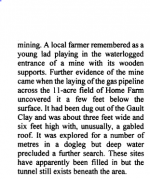You are using an out of date browser. It may not display this or other websites correctly.
You should upgrade or use an alternative browser.
You should upgrade or use an alternative browser.
Any East Anglian Folks In The House?
- Thread starter Ttxela
- Start date
Apart from a chalk mine near Norwich that got sealed up due to hydrogen Sulphide issues, what's underground in East Anglia?
I thought I was cursed in Essex but East Anglia can't be that much better if you mean Cambridgeshire Norfolk and Suffolk? give or take some chalk pits and that fraudulent coal mine at Linton (outside Cambridge) I think we discussed once on UKCaving Unless you mean man made structures (also good for a look)
Unless you mean man made structures (also good for a look)
I thought I was cursed in Essex but East Anglia can't be that much better if you mean Cambridgeshire Norfolk and Suffolk? give or take some chalk pits and that fraudulent coal mine at Linton (outside Cambridge) I think we discussed once on UKCaving
Don't you have some top secret dinosaur dung mines down there?
David_Hall_Witt
Member
Hey, I'm from Bedfordshire, but normally in N-Wales the Peaks, or down south, its pretty sparse to say the least round here hahaMyself
Chris jc
Also a chap has posted from Bedford if you search that word
Not sure they're top secret, came to my attention while searching for Essex mines as some Red Crag formation sneaks into the North East corner of Essex, but AFAIK it was surface working outcrop on low seaside cliff area and only really worked in Suffolk. Ipswich even has a street called Coprolite Street.Don't you have some top secret dinosaur dung mines down there?
Unless those are the ones they want me to know about, and the miles of vast Suffolk cavern system are kept ultra secret from people like me
Depending exactly where you are, old railway tunnels etc, maybe not the same as the Peak or Wales.Hey, I'm from Bedfordshire, but normally in N-Wales the Peaks, or down south, its pretty sparse to say the least round here haha
I'll happily swap Essex and Beds for underground exploration
Flint mines, if you think about it, are where miners from these islands probably first learnt the hard way about the stability of ground and how much can be dug away without causing the ground to move! The whole of the British mining industry owes it to prehistoric miners from this area for their brave endeavours. Of course, Sussex had flint mines long before East Anglia!
Ttxela
Active member
"In most cases the coprolites had to be dug out from between 3 and 6 metres. Toolsranged from simple shovels, pick axes and crowbars to more extensive workings withplanks and even tramways to ship the material excavated. At Bassingbourn a shaft wasdug and the material brought up by steam power. However, most mining was open castand even at Bassingbourn they soon returned to more conventional methods as theseams were not very thick."
https://www.meldrethhistory.org.uk/documents/The_Coprolite_Industry_in_South_East_Cambridgeshire.pdf
I've never quite been able to locate the site of the shaft.
https://www.meldrethhistory.org.uk/documents/The_Coprolite_Industry_in_South_East_Cambridgeshire.pdf
I've never quite been able to locate the site of the shaft.
David_Hall_Witt
Member
yeah some of the train tunnels are ok, but it doesn't quite scratch the itch! hahahaDepending exactly where you are, old railway tunnels etc, maybe not the same as the Peak or Wales.
I'll happily swap Essex and Beds for underground exploration
dougle89
Active member
mining turds seems like such a crazy venture that it's almost unbelievable, thank you for that link!"In most cases the coprolites had to be dug out from between 3 and 6 metres. Toolsranged from simple shovels, pick axes and crowbars to more extensive workings withplanks and even tramways to ship the material excavated. At Bassingbourn a shaft wasdug and the material brought up by steam power. However, most mining was open castand even at Bassingbourn they soon returned to more conventional methods as theseams were not very thick."
https://www.meldrethhistory.org.uk/documents/The_Coprolite_Industry_in_South_East_Cambridgeshire.pdf
I've never quite been able to locate the site of the shaft.
Sounds like amining turds seems like such a crazy venture that it's almost unbelievable, thank you for that link!
As my grandad used to say (imagine a very strong Lancashire accent, like Fred Dibnah but stronger) "Where there's muck.. there's brass"Sounds like aJob
Ttxela
Active member
There's also an excellent PDMHS Bulletin article
https://pdmhs.co.uk/MiningHistory/B...lopment of the British Coprolite Industry.pdf

https://pdmhs.co.uk/MiningHistory/B...lopment of the British Coprolite Industry.pdf

Toolsranged from simple shovels, pick axes and crowbars
Yes. I've had to resort to that when dealing with our bog.
BikinGlynn
Member
Myself
Chris jc
Also a chap has posted from Bedford if you search that word
& me
